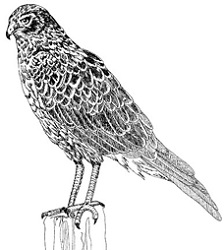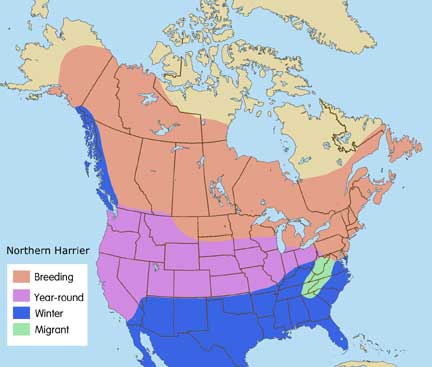
Scientific Name: Circus hudsonius formerly Circus cyaneus
A slender, graceful raptor of the open country with long legs, long wings, a long tail, and a dark-hooded, owl-like face. Females are larger than males, and the adult plumages of the two sexes are very different. Females are brown above, buffy below, with the chest and sides heavily-streaked with brown, and lighter streaking and spotting on the belly. The underwing shows heavy barring of the flight feathers. The male is pale blue-gray above, and mostly white below, with some small rufous spotting on the chest and belly.
Wing tips and trailing edges of the wing are black. Juveniles look like females, with a reddish tinge to their plumage. A white patch on the upper tail near the base is a distinctive feature on both sexes. The Northern Harrier also has a unique disc of facial feathers, giving them an owlish appearance, that probably helps them hunt by ear – useful in areas of high grass. These birds are often seen flying low, back and forth over the ground, with wings held in a bold dihedral – a “harrying” pattern of flight used while out hunting. Their long, narrow wings are very flexible in flight, and they tend to bounce around unsteadily in winds.
Male
Length: 16 – 18 ”
Wingspan: 38 – 43″
Weight: 10 – 14 oz.
Female
Length: 18 – 20″
Wingspan: 43 – 48″
Weight: 14 – 21 oz.
State and federally protected.
As the common name of “marsh hawk” suggests, this species likes fresh and saltwater marshes. Can be found in a variety of other open areas, such as wet meadows, grasslands, prairies, tundra, and cultivated areas – all generally at low elevations.
Eats a variety of food, with males tending to take more birds, females taking more small mammals. They most commonly hunt by zigzagging low over the ground, pouncing quickly when prey is found. These birds use many other hunting techniques as well – perch hunting, hover hunting, stooping (diving from high above), pirating prey from other species, even running prey down on foot through dense brush.
Generally quiet, but can give a piercing, whistling alarm call of eeya,eeya,eeya.
Breeds only in wetland or grassland habitats. The male puts on a performance of aerial acrobatics called “sky dancing” to court the female, advertising his hunting prowess – males often pass food to their mates in mid-air. Northern Harriers are also the only polygamous hawks in North America. Build nests of grass on the ground, hidden by the marsh vegetation.
These grassland and marshland ground nesters often have their well-hidden nests exposed or destroyed by mowing machines.

Breeds from N. Alaska and Canada, south throughout the US and into Central America; winters from coastal British Columbia, south across the US into its southern range, excluding the Northern Rockies and Northern Great Plains. The Northern Harrier is the only species of harrier on this continent, although ten species are known worldwide.
Special Thanks for range maps:
Dan Gleason
BGleason Design & Illustration
Commercial & Scientific Illustration, Graphic Design
CraneDance Communications
Book Production/Design

